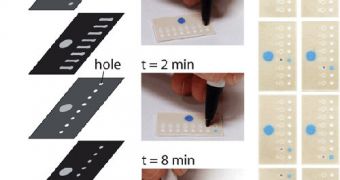Microfluidic devices are a promising class of equipment that could in the near future be used for a wide variety of applications, from applying diagnostics to analyzing the degree of contamination in a chemical or biological sample. The instruments are very small, the size of a chip, and they all contain small channels through which liquid can flow. Now, researchers at Harvard University created a microfluidic device that can be programmed according to its handler's wishes, by using nothing more than a ball-point pen, Chemistry World reports.
The paper-based lab-on-a-chip is extremely well suited for conducting water purity studies, and for research into new drugs. It is also extremely cheap, as it is based on paper. This ensures that agencies and organizations in the developing world – for which the new devices are meant – can purchase them, and then distribute them in the field. Microfluidic devices rely on the capillary action of the small channels they contain. Basic fluid physics dictates how the samples move through these channels, which contain various markers for a variety of objectives.
For example, chips designed to detect malaria contain markers for the condition, which shift color when they detect the infection. As such, a simple piece of paper can detect the spread of malaria in an area that is too poor to afford high-standard healthcare. Moving the technology one step forward, the Harvard team managed to design a device that can be programmed to execute a variety of tasks. This is accomplished as the expert using the chip uses a ball-point pen to make the necessary adjustments. The innovation was achieved in the lab of Harvard expert George Whitesides.
“Using these inexpensive materials is key for the medical micro-device field, which has to date been dominated by silicon, glass and polydimethlysiloxane (PDMS) materials,” explains Rice University microfluidic devices expert John McDevitt. The Harvard team only uses paper, a polymer solution and light to create its instrument. Pieces of paper are soaked with the solution, and are then exposed to light. This causes the mix to harden, producing a lab-on-a-chip that is impermeable, and which features small channels that can handle various samples.

 14 DAY TRIAL //
14 DAY TRIAL //